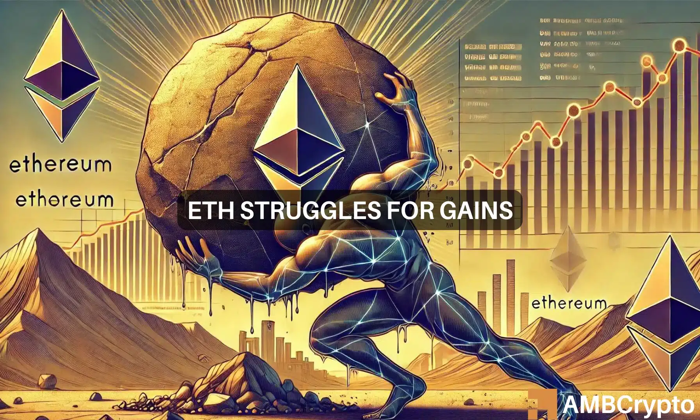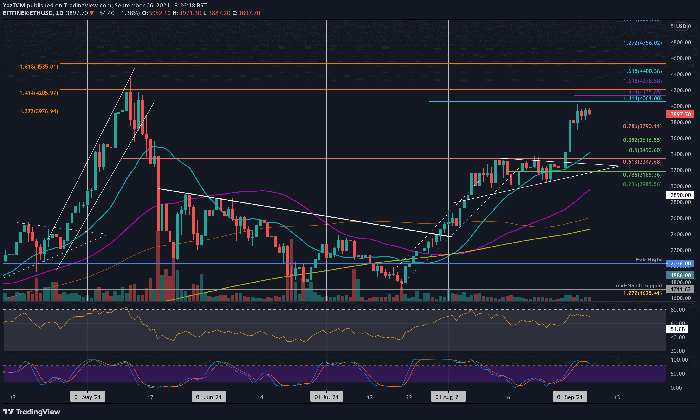Ethereum struggles continue to dominate the conversation in the crypto space, particularly as the asset grapples with persistent price volatility and disappointing ETF results. The recent decline in Ethereum spot volume, plummeting by an astonishing 80% since its peak in December 2024, highlights waning demand among investors. This dramatic reduction reflects the profound impact of the current crypto market trends, where Ether has seen difficulty breaking past the crucial $2,750 resistance level, despite a notable surge earlier this month. Moreover, the average losses faced by Ethereum ETF investors, currently sitting at around 21%, only add to the narrative of uncertainty surrounding the altcoin’s future. As analysts provide varied Ethereum price predictions, many remain skeptical about Ether’s ability to recover and thrive amidst fierce market competition and evolving investor sentiments.
The challenges ahead for Ethereum are becoming increasingly apparent as it contends with issues such as market instability and diminished investor interest. Not only is Ethereum facing significant fluctuations in its price, but it also grapples with lagging demand for Ether, which has failed to rally even amidst a broader crypto rebound. The proliferation of Ethereum-based ETFs has not yielded the expected momentum, leading to considerable losses for investors who entered the market with high hopes. Furthermore, the overarching trends within the cryptocurrency markets are indicative of a shifting landscape where Ethereum must adapt or risk falling further behind its peers like Bitcoin and Solana. In light of these hurdles, understanding the complexities surrounding Ethereum’s performance is crucial for anyone looking to navigate the evolving digital asset ecosystem.
Ethereum Struggles: Analyzing Price Volatility
Ethereum has faced significant challenges recently, particularly in terms of price volatility which has become one of the foremost topics of discussion among crypto enthusiasts. With its inability to break the $2,750 resistance level, concerns about Ether’s price stability are rising. Historical data shows that price fluctuations of over 120% were commonplace in earlier cycles; however, as the asset matured, current figures hover around 80%. This compression of volatility, combined with unexpected spikes even during price declines, signals a troubling pattern that could lead to further investor uncertainty.
Such volatility is driven by various factors, including speculative trading and changes in Ether demand. In recent months, Ethereum’s realized volatility has exhibited unusual behavior, climbing over 90% during price declines which contradicts traditional market trends. Investors need to evaluate whether the current market conditions will stabilize or if further volatility is on the horizon, affecting Ethereum price predictions for the coming months.
Impact of Ethereum ETF Losses on the Market
The introduction of Ethereum ETFs by major firms like BlackRock and Fidelity initially sparked excitement in the crypto community. However, current analysis reveals that the average investor in these ETFs has experienced substantial unrealized losses averaging around 21%. This disappointing performance underscores the challenges facing Ethereum as it tries to build investor confidence amid increasing ETF losses. Notably, net outflows from these funds tend to spike when Ether’s price dips below its average cost basis, as seen during significant downturns.
This pattern indicates a cautious sentiment among investors who have anticipated greater success for these financial products. Despite a peak trade volume of over 2.5% shortly after launch, the recent regression back to 1.5% highlights the frigid reception the ETFs have experienced in the broader crypto market trends. As Ethereum struggles to reclaim highs, the implications of ETF performance could further complicate its path toward recovery.
Current Trends in Ether Demand and Market Participation
The recent decrease in trading volumes, which plummeted by 80% from highs in December 2024, starkly illustrates the waning demand for Ethereum in the current market environment. With the latest figures showing daily spot volume hovering around $2.9 billion, crypto market trends suggest a lack of enthusiasm from both retail and institutional investors. Historically, high participation rates have been essential for driving capital inflows and sustaining price levels, making the current downturn a critical point of concern for Ether enthusiasts.
In the context of reduced liquidity and capital flow, the Realized Cap’s growth of just 38% since January 2023 serves as a warning sign for Ethereum’s future performance. This muted growth, especially in contrast to explosive increases during the last major cycle, highlights the need for a revitalization of market sentiment towards Ether to bolster demand and facilitate a recovery toward predicted price levels.
Ethereum Price Predictions Amidst Ongoing Struggles
As the Ethereum market navigates through its ongoing struggles with volatility and ETF losses, analysts are cautiously optimistic, projecting possible prices above $3,000 by mid-2025. However, these predictions are tempered with significant uncertainty fueled by recent patterns indicating increased caution among investors. This condition creates a complex environment for Ethereum price forecasting, as market trends and investor sentiments fluctuate.
Predictions of an upward surge to the $3,000 mark presume a stabilizing market for Ether and renewed interest among both speculative traders and long-term holders. Given the demonstrated volatility and lack of fresh all-time highs, these projections are ambitious yet remain dependent on forthcoming market developments. The interplay of Ether demand and speculative interest will be crucial in determining whether Ethereum can shift away from its current struggles.
Volatility and Its Effect on Future Ethereum Developments
The extended volatility experienced by Ethereum is not merely a statistical anomaly; it profoundly influences future developments and investor strategies. As volatility spikes have become common, the implications for future price movements are critical. Investors must approach Ethereum with caution, adjusting their strategies in response to ongoing market changes, including crypto market trends that could signal either recovery or further challenges.
This scenario necessitates a shift in how Ethereum is perceived within the broader crypto landscape. If the volatility persists, Ether could be viewed less as a stable investment and more as a speculative asset, compelling developers and stakeholders to adapt and innovate in ways that enhance utility and attract stable demand, potentially safeguarding against future price swings.
Examining Ethereum’s Historical Price Trends for Insights
To understand Ethereum’s current struggles, examining its historical price trends provides valuable insights. In past cycles, Ether typically saw significant increases in volatility followed by periods of impressive growth. The current landscape, however, shows a stark divergence, with trends suggesting a pattern of declining price action and less pronounced recovery phases. This could indicate deeper structural issues that are unique to this cycle, as reflected in the absence of new all-time highs compared to other cryptocurrencies like Bitcoin.
Utilizing historical data in conjunction with current market conditions might help investors gain a clearer perspective on Ethereum’s potential future movements. Such analysis can also inform Ethereum price predictions, allowing for a more nuanced understanding of what factors could propel or hinder its growth moving forward.
The Importance of Liquidity in Ethereum’s Trading Landscape
Liquidity plays a vital role in Ethereum’s trading landscape, especially in light of the recent downturn in spot volume. As noted, trading volume fell dramatically from peaks of $14.7 billion to just $2.9 billion per day. This drastic decrease not only reflects a shrinking market appetite for Ether but also limits its price movement potential. Active liquidity allows for smoother transactions and can mitigate vast price swings that affect overall stability.
With constrained liquidity, Ethereum faces heightened risks of further volatility and price suppression, making it imperative for market participants to monitor conditions closely. Strategies to increase liquidity participation in Ethereum trading could be pivotal in regaining investor confidence and fostering a more stable market environment.
Investor Sentiment: The Key Factor for Ethereum’s Recovery
Investor sentiment is arguably the most crucial factor influencing Ethereum’s potential recovery. The current market climate, characterized by increasing ETF losses and fluctuating demand, has left many investors feeling uneasy. Understanding the psychological factors at play can help market participants gauge future movements more effectively. Positive news surrounding Ethereum could lead to an influx of interest and capital, while ongoing struggles may continue to dampen enthusiasm.
To reverse the current downturn, Ethereum must strive to restore trust and demonstrate resilience against historical pressures. By enhancing transparency and adapting to market demands, Ethereum can hope to rebuild investor sentiment and towards a more optimistic future. Ultimately, this psychological component could determine whether Ethereum also successfully navigates its current cycle of struggles.
Comparing Ethereum to Competitors in the Crypto Market
In order to contextualize Ethereum’s current struggles, it is essential to compare its performance against competitors such as Bitcoin and Solana. These assets have witnessed new all-time highs during the same cycle when Ethereum has failed to establish such peaks. This stark comparison accentuates the challenges Ethereum faces in regaining market share and investor confidence. Market trends indicate a redistribution of capital toward more promising assets unless Ethereum can demonstrate potential for growth.
As Ethereum attempts to reclaim its standing in the crypto ecosystem, understanding competitive dynamics and market sentiment is crucial. Adapting strategies in response to competitor performance may offer pathways to reclaim investor interest and improve overall liquidity, which are vital to overcoming the current struggles inherent in Ethereum’s market position.
Frequently Asked Questions
What are the main reasons behind Ethereum’s struggles with price volatility?
Ethereum’s struggles with price volatility stem from a combination of factors including market uncertainty, decreased demand for Ether, and the atypical increases in volatility observed during recent price declines. Notably, despite some price gains, the failure to break above key resistance levels like $2,750 reflects deeper underlying issues affecting investor sentiment.
How have Ethereum ETFs contributed to the struggles in Ether’s market performance?
Ethereum ETFs have shown significant struggles, with the average investor experiencing unrealized losses of around 21%. Initially, they generated excitement, but when Ethereum’s price fell below the average cost basis, net outflows increased, signaling waning investor confidence, which further exacerbates Ethereum’s struggles in the current market.
What impact do current crypto market trends have on Ethereum’s struggles?
Current crypto market trends, characterized by a downturn in trading volume and decreased capital inflows, significantly impact Ethereum’s struggles. The sharp 80% drop in spot volume since December 2024 highlights a lack of market appetite for Ether, complicating its recovery and stability.
How has Ether demand influenced Ethereum’s price prediction amid its ongoing struggles?
The subdued demand for Ether has directly contributed to its price prediction challenges amidst ongoing struggles. With a mere 38% increase in Realized Cap since January 2023, compared to exponential growth in previous cycles, the current sentiment suggests cautious forecasts for Ethereum’s price trajectory, keeping it below historical highs.
What are the implications of Ethereum’s volatility on future price predictions?
The implications of Ethereum’s volatility on future price predictions are critical, as the atypical increase in volatility amidst price declines suggests significant market uncertainty. This could lead to tempered expectations, as recent patterns indicate that breaking through resistance levels remains an uphill battle for Ether, influencing overall price predictions for the coming months.
| Key Points | Details |
|---|---|
| Spot Volume Decline | Spot volume on exchanges dropped 80% post-December 2024 highs, indicating low demand. |
| Price Resistance Level | Ether struggles to surpass the $2,750 resistance despite a 44% price increase this month. |
| Realized Volatility | The current realized volatility is around 80%, down from 120%, with unusual spikes during price declines. |
| Lack of New ATH | Ether failed to set a new all-time high unlike competitors Bitcoin and Solana during this cycle. |
| Drawdown History | Severe drawdowns exceeding 40%, with a 2025 peak drawdown at 65.4%, indicating structural weaknesses. |
| Capital Inflows | Realized Cap increased by only 38% since January 2023, revealing weaker liquidity support. |
| Exchange Activity | Daily spot volume dropped from $14.7 billion to $2.9 billion, failing to reach previous cycle highs. |
| ETF Performance | Investors in ETH ETFs from major firms face unrealized losses of about 21%, with declining trade volume. |
Summary
Ethereum struggles in the current market, facing significant volatility and a lack of investor demand. Despite a noticeable price increase, the inability to break key resistance levels and the substantial decrease in trading volumes highlight serious concerns. The lack of new all-time highs compared to its peers and severe drawdowns signify a challenging future for investors. As market dynamics evolve, it’s crucial to monitor Ethereum’s performance and investor sentiment closely.
Ethereum struggles have become increasingly evident as the altcoin faces significant challenges in a rapidly evolving crypto landscape. Notably, Ethereum price volatility has persisted, with fluctuations dampening investor confidence amid subdued demand for Ether. The recent losses reported in Ethereum ETFs have further compounded these difficulties, reflecting a broader trend of hesitance among institutional investors. As crypto market trends continue to shift, many are left pondering the implications for Ethereum price predictions in the near future. With these mounting pressures, it’s crucial to examine the underlying factors contributing to this turmoil within the Ethereum ecosystem.
The ongoing difficulties in the Ethereum network highlight serious issues that many in the cryptocurrency community have begun to notice. Recent analyses suggest that the turbulence in Ether’s market behavior, characterized by unpredictable price movements and challenges in attracting interest, reflects a broader malaise affecting this blockchain platform. Additionally, institutional interest, as demonstrated by Ethereum ETFs, has not translated into robust demand, leading to substantial financial losses for investors. This backdrop raises questions about future market dynamics and potential recovery pathways in the face of growing competition and shifting investor sentiment. Understanding these factors is vital for anyone looking to navigate Ethereum’s uncertain environment.















